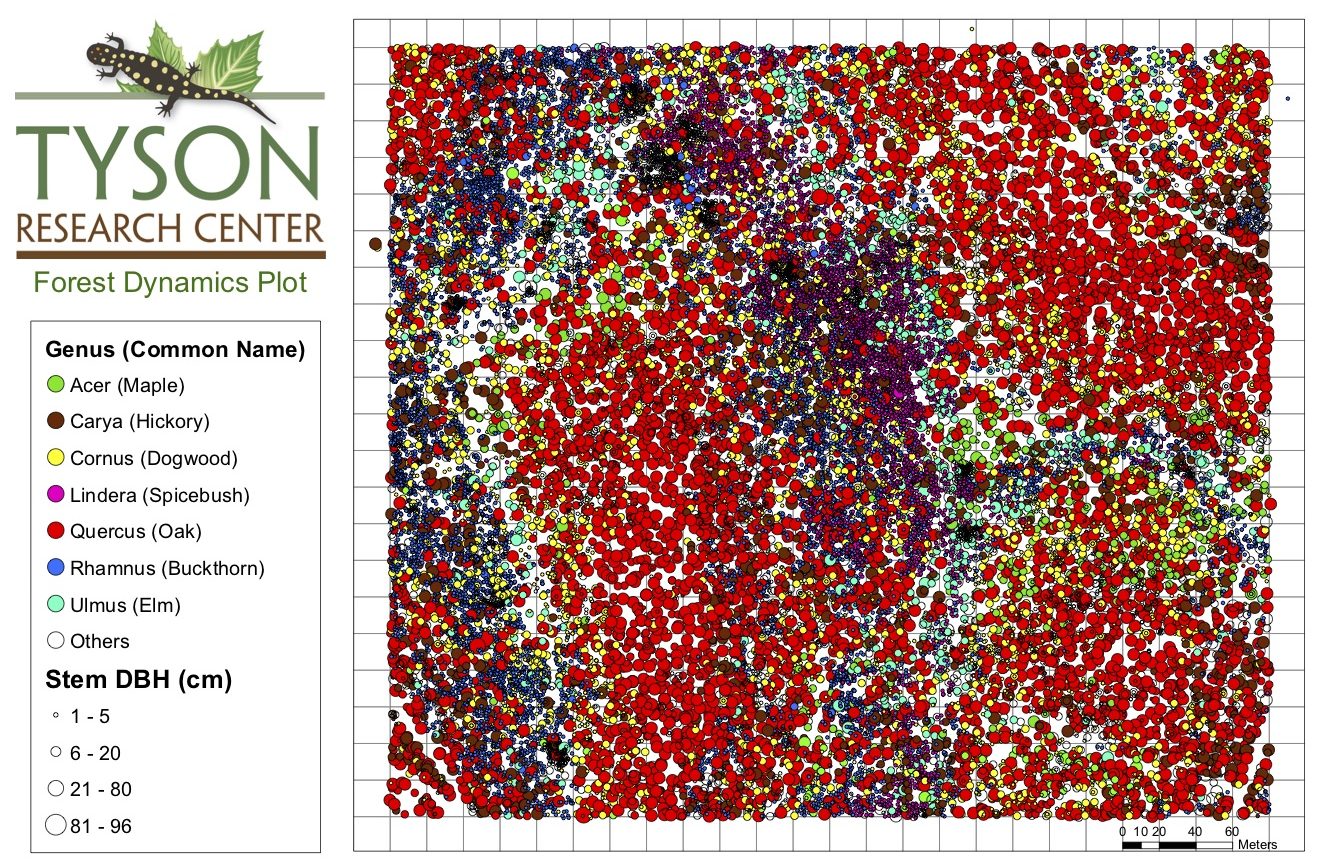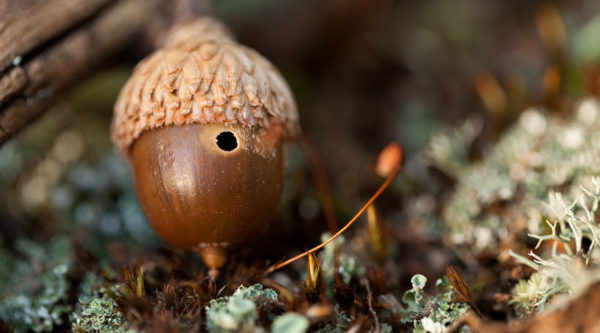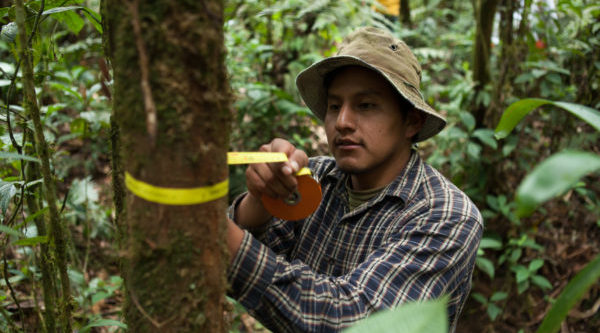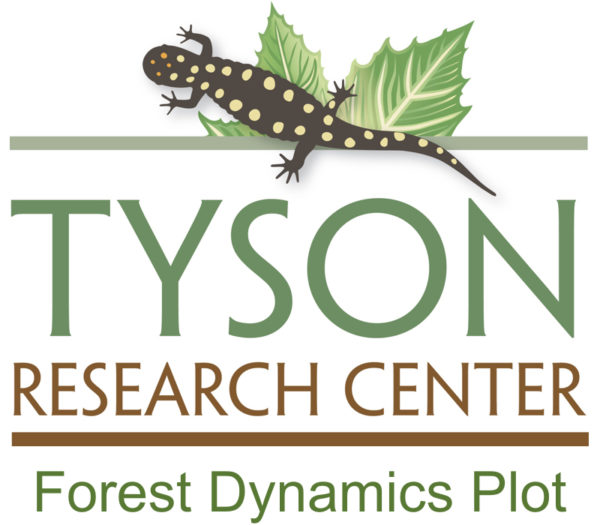Community Assembly across Temperate and Tropical Regions
What processes drive biodiversity and community assembly
within and across temperate and tropical ecosystems?


Temperate Oak-Hickory Forest – Missouri Ozarks (top) & Tropical Rainforest – Peruvian Amazon (bottom) (Photos: J. Myers)
Mechanisms of Community Assembly Across Temperate and Tropical Forests
One of the most prominent and ubiquitous patterns of life on earth is the systematic increase in species diversity from temperate to tropical latitudes. Yet the processes underlying this and other prominent biodiversity gradients have been difficult to distinguish because different processes operating at multiple scales may determine geographic variation in biodiversity. To untangle these processes, we are investigating the way in which deterministic and stochastic community assembly processes at local scales (e.g., dispersal limitation, ecological drift, niche selection resulting from abiotic conditions or biotic interactions within and among species) interact with processes at larger spatiotemporal scales (e.g., speciation and its influence on the composition of regional species pools) to create variation in community composition (beta-diversity), functional-trait diversity, and species diversity within and across temperate and tropical regions.
Local Biotic Interactions and Large-Scale Diversity Gradients
Distance- or density-dependent pathogens and predators are thought to maintain biodiversity by limiting abundances of common species and stabilizing populations of rare species, a process known as negative density dependence. This process was originally hypothesized to explain why there are so many more tree species in tropical latitudes compared to temperate latitudes. Despite decades of interest in negative density dependence, surprisingly little is known about the relative importance of negative density dependence in creating and maintaining biodiversity at different spatial scales, the ecological factors that mediate the strength of negative density dependence through space or time, and the ways in which negative density dependence interacts with processes at larger scales to determine biodiversity and community assembly. We are investigating these questions by exploring the role of negative density dependence in determining patterns of tree species richness, beta-diversity, and biodiversity-environment relationships at local, continental, and global scales.
Related Publications
Current and former members of our research group in bold. **Undergraduate student
*Myers, Jonathan A. & Kaoru Kitajima. 2007. Carbohydrate storage enhances seedling shade and stress tolerance in a neotropical forest. Journal of Ecology 95:383-395. Abstract PDF Supplementary Material *Recommended by the Faculty of 1000
Myers, Jonathan A., Jonathan M. Chase, Iván Jiménez, Peter M. Jørgensen, Alejandro Araujo-Murakami, Narel Paniagua-Zambrana & Renate Seidel. 2013. Beta-diversity in temperate and tropical forests reflects dissimilar mechanisms of community assembly. Ecology Letters 16: 151-157. Abstract PDF Supporting Information
Myers, Jonathan A., Jonathan M. Chase, Raelene M. Crandall & Iván Jiménez. 2015. Disturbance alters beta-diversity but not the relative importance of community assembly mechanisms. Journal of Ecology 103: 1291-1299. Abstract PDF Data Cover Article
*Chase, Jonathan M. & Jonathan A. Myers. 2011. Disentangling the importance of ecological niches from stochastic processes across scales. Philosophical Transactions of the Royal Society B 366: 2351-2363. Abstract PDF
*Invited Paper for Special Issue: Biogeography and Ecology – Two Views of One World
LaManna, Joseph A., Scott A. Mangan, Alfonso Alonso, Norman A. Bourg, Warren Y. Brockelman, Sarayudh Bunyavejchewin, Li-Wan Chang, Jyh-Min Chiang, George B. Chuyong, Keith Clay, Richard Condit, Susan Cordell, Stuart J. Davies, Tucker J. Furniss, Christian P. Giardina, I. A. U. Nimal Gunatilleke, C. V. Savitri Gunatilleke, Fangliang He, Robert W. Howe, Stephen P. Hubbell, Chang-Fu Hsieh, Faith M. Inman-Narahari, David Janík, Daniel J. Johnson, David Kenfack, Lisa Korte, Kamil Král, Andrew J. Larson, James A. Lutz, Sean M. McMahon, William J. McShea, Hervé R. Memiaghe, Anuttara Nathalang, Vojtech Novotny, Perry S. Ong, David A. Orwig, Rebecca Ostertag, Geoffrey G. Parker, Richard P. Phillips, Lawren Sack, I-Fang Sun, J. Sebastián Tello, Duncan W. Thomas, Benjamin L. Turner, Dilys M. Vela Díaz, Tomáš Vrška, George D. Weiblen, Amy Wolf, Sandra Yap & Jonathan A. Myers. 2017. Plant diversity increases with the strength of negative density dependence at the global scale. Science 356: 1389-1392 Abstract PDF Supplementary Material and R code
- Commentary: “How latitude affects biotic interactions” (Comita 2017, Science)
- News Coverage: “Global forest network cracks the case of tropical biodiversity” (Washington University Newsroom)
- News Coverage: “Is this the long-sought answer to the question of tropical biodiversity?” (Smithsonian News Desk)
- News Coverage: “Why do we see more species in tropical forests? The mystery may finally be solved” (Smithsonian Magazine)
LaManna, Joseph A. […] & Jonathan A. Myers (49 total authors). 2018. Response to Comment on “Plant diversity increases with the strength of negative density dependence at the global scale”. Science 360: eaar3824 Abstract PDF R Code
LaManna, Joseph A. […] & Jonathan A. Myers (49 total authors). 2018. Response to Comment on “Plant diversity increases with the strength of negative density dependence at the global scale”. Science 360: eaar5245 Abstract PDF R Code
LaManna, Joseph A., R. Travis Belote, Laura A. Burkle, Christopher P. Catano & Jonathan A. Myers. 2017. Negative density dependence mediates biodiversity-productivity relationships across scales. Nature Ecology & Evolution 1: 1107-1115. Abstract PDF
LaManna, Joseph A., Maranda L. Walton, Benjamin L. Turner & Jonathan A. Myers. 2016. Negative density dependence is stronger in resource-rich environments and diversifies communities when stronger for common but not rare species. Ecology Letters 19: 657-667. Abstract PDF
Spasojevic, Marko J., Benjamin L. Turner & Jonathan A. Myers. 2016. When does intraspecific trait variation contribute to functional beta-diversity? Journal of Ecology 104: 487-496. Abstract PDF
Spasojevic, Marko J., **Elizabeth A. Yablon, Brad Oberle & Jonathan A. Myers. 2014. Ontogenetic trait variation influences tree community assembly across environmental gradients. Ecosphere 5: article 129. Abstract PDF
Spasojevic, Marko J., **Katherine Harline, Claudia Stein, Scott A. Mangan & Jonathan A. Myers. 2019. Landscape context mediates the relationship between plant functional traits and decomposition. Plant and Soil 438: 377-391. Abstract PDF
Oberle, Brad, Marissa Lee, Jonathan A. Myers, Oyomoare Osazuwa-Peters, Marko J. Spasojevic, Maranda L. Walton, Darcy F. Young, & Amy E. Zanne. 2019. Accurate forest projections require long-term wood decay experiments because plant trait effects change through time. Global Change Biology (In Press). Abstract PDF
Oberle, Brad, Amy M. Milo, Jonathan A. Myers, Maranda L. Walton, Darcy F. Young & Amy E. Zanne. 2016. Direct estimates of downslope deadwood movement over 30 years in a temperate forest illustrate impacts of treefall on forest ecosystem dynamics. Canadian Journal of Forest Research 46: 351-361. Abstract PDF
Kraft, Nathan J.B., Liza S. Comita, Jonathan M. Chase, Nathan J. Sanders, Nathan G. Swenson, Thomas O. Crist, James C. Stegen, Mark Vellend, Brad Boyle, Marti J. Anderson, Howard V. Cornell, Kendi F. Davies, Amy L. Freestone, Brian D. Inouye, Susan P. Harrison & Jonathan A. Myers. 2011. Disentangling the drivers of β diversity along latitudinal and elevational gradients. Science 333: 1755-1758. Abstract PDF Supporting Material Cover Article
Tello, J. Sebastián, Jonathan A. Myers, Manuel J. Macía, Alfredo F. Fuentes, Leslie Cayola, Gabriel Arellano, M. Isabel Loza, Vania Torrez, Maritza Cornejo & Peter M. Jørgensen. 2015. Elevational gradients in beta-diversity reflect variation in the strength of local community assembly mechanisms across spatial scales. PLoS ONE 10: e0121458. Abstract PDF Supporting Material
Anderson-Teixeira, Kristina J., Stuart J. Davies […] Jonathan A. Myers […] & Jess Zimmerman (108 total authors). 2015. CTFS-ForestGEO: A worldwide network monitoring forests in an era of global change. Global Change Biology 21: 528-549. Abstract PDF Supporting Information
Chengjin Chu, James A. Lutz, Kamil Král, Tomáš Vrška, Xue Yin, Jonathan A. Myers […] Gary G. Mittelbach & Fangliang He (73 total authors). 2019. Direct and indirect effects of climate on richness drive the latitudinal diversity gradient in forest trees. Ecology Letters 22:245-255. Abstract PDF
Wang, Xugao, Thorsten Wiegand, Kristina J. Anderson-Teixeira, Norman A. Bourg, Zhanqing Hao, Robert Howe, Guangze Jin, David A. Orwig, Marko J. Spasojevic, Shunzhong Wang, Amy Wolf & Jonathan A. Myers. 2018. Ecological drivers of spatial community dissimilarity, species replacement, and species nestedness across temperate forests. Global Ecology and Biogeography 27: 581-592. Abstract PDF
*Ellison, Aaron M., Hannah L. Buckley, Bradley S. Case, Dairon Cardenas, Alvaro J. Duque, James A. Lutz, Jonathan A. Myers, David A. Orwig & Jess K. Zimmerman. 2019. Species diversity associated with foundation species in temperate and tropical forests. Forests 10: 128. Abstract PDF
*Invited Paper for Species Issue: Causes and Consequences of Species Diversity in Forest Ecosystems
Buckley, Hannah L., Bradley S. Case, Jess K. Zimmerman, Jill Thompson, Jonathan A. Myers & Aaron M. Ellison. 2016. Using codisperson analysis to quantify and understand spatial patterns in species-environment relationships. New Phytologist 211: 735-749. Abstract PDF Supporting Information
Fisher, Joshua B., Sean Sweeney, Edward R. Brzostek, Tom P. Evans, Daniel J. Johnson, Jonathan A. Myers, Norman A. Bourg, Amy T. Wolf, Robert W. Howe & Richard P. Phillips. 2016. Tree–mycorrhizal associations detected remotely from canopy spectral properties. Global Change Biology 22: 2596-2607. Abstract PDF
- News Coverage: “NASA Satellite Images Uncover Underground Forest Fungi” (NASA Earth Science News)
- News Coverage: “Satellites Detect the Healthy Glow of a Forest with Underground Friends” (Smithsonian News Desk)
- Teaching Publication: Fisher, Joshua B., Sean Sweeney, Edward R. Brzostek, Tom P. Evans, Daniel J. Johnson, Jonathan A. Myers, Norman A. Bourg, Amy T. Wolf, Robert W. Howe & Richard P. Phillips. 2016. What kind of fungus are you? Science Journal for Kids, November 2016. Web PDF
Lutz, James A., Tucker J. Furniss, Daniel J. Johnson […] Jonathan A. Myers […] & J. K. Zimmerman (98 total authors). 2018. Global importance of large-diameter trees. Global Ecology and Biogeography 27: 849-864. Abstract PDF Cover Article
- News Coverage: “Inequality is normal: Dominance of the big trees“ (EurekAlert!)
Menge, Duncan N. L., Ryan A. Chisholm, Stuart J. Davies […] Jonathan A. Myers […] & Tak Fung (81 total authors). 2019. Patterns of nitrogen-fixing tree abundance in forests across Asia and America. Journal of Ecology 107: 2598-2610. Abstract PDF
Study Sites
Our study sites include: 1) the Tyson Research Center Forest Dynamics Plot, a long-term, 20-ha temperate-forest plot located at Washington University’s field station in the Missouri Ozarks, and part of the 2) Smithsonian Forest Global Earth Observatory (ForestGEO), the largest, systematically-studied network of forest-dynamics plots in the world (67 plots in 27 countries) (Anderson-Teixeira et al. 2015); 3) a regional network of 0.1-ha temperate-forest plots across the Missouri Ozarks (Myers et al. 2013); and 4) the Madidi Project, a network of 440 0.1-ha and 48 1-ha tropical-forest plots distributed across a 4,000-m elevational gradient spanning the Bolivian Andes to Amazon (Tello et al. 2015).
Map: Tyson Research Center Forest Dynamics Plot, Missouri, showing locations of 30,328 trees (circles) in 2013 (map credit: Francis Baum).

Photo Galleries & Videos
The Story and Science of a Forest Global Earth Observatory
Global Forest Network Cracks the Case of Tropical Biodiversity
Tyson Research Center Forest Dynamics Plot, Missouri
Madidi Project Expedition, Bolivia






